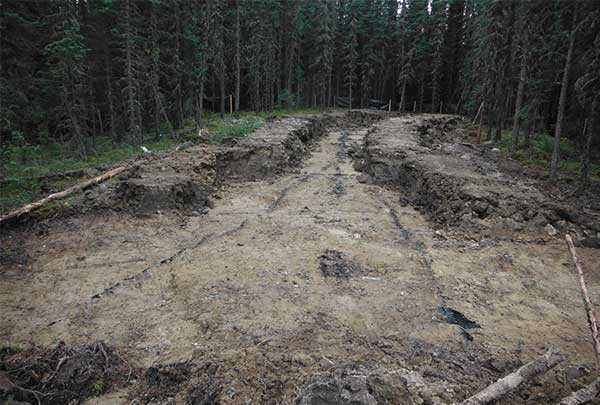The Alberta energy regulator has suspended the fastest-growing source of bitumen production around Fort McMurray due to concerns about fracturing the region’s cap rock.
Last January, the regulator quietly issued a bulletin announcing the freeze on development in the Wabiskaw-McMurray deposit of the Athabasca Oil Sands Area while it completes “a thorough technical review of the factors that affect reservoir containment of steam-assisted gravity drainage (SAGD) projects.”
The suspension affects the development of steam operations in one hundred townships where bitumen developers plan to inject hot steam 100 to 150 metres into the ground to melt shallow formations of bitumen.
To date, five companies have been affected by the freeze including Silver Willow Energy and Ivanhoe Energy, whose 7,520-acre Tamarack Project is valued at $1.8 billion.
“The [regulator] believes that the risk of steam and reservoir fluids being released at surface is greater if reservoir containment is compromised in this area due to the shallow nature of the resource,” reported the bulletin.
A cap rock must have "sufficient thickness and competency and be continuous across the project area to contain steam and heated reservoir fluids."
The freeze does not apply to high pressure cyclic steam operations in Cold Lake where industrial plants often blast steam to surface, groundwater and other company leases, and where steaming techniques not only heave the ground by 36 centimetres but damage hundreds of wellbores.
Review long overdue: critics
Geomechanical engineers have warned for years that steam plant operations that extract bitumen from formations just 100 metres from the surface are much riskier than deeper formations and require “more careful determination of maximum operating pressure” for the steam.
Preventing bitumen blowouts to the surface cap rock integrity demands high degrees of complexity, including “comprehensive field measurements, detailed laboratory measurements and collation of all information in a geo-mechanical modeling exercise to determine the safe maximum operating pressure.”
Critics say the technical review is long overdue and highlights growing problems with different kinds of in situ technology, including toxic air pollution in Peace River, dramatic bitumen releases in Cold Lake, groundwater depletion and contamination in Athabasca and rising steam-to-bitumen ratios, an indicator of extreme energy waste.
“Alberta’s review and permitting process for high-pressure bitumen extraction projects has been overly permissive and risky for groundwater, surface lands and wildlife resources,” says Carolyn Campbell of the Alberta Wilderness Association.
Campbell would like to see more restrictions on steaming projects “where cap-rock layers can be fractured by geological weaknesses, such as the dissolving salts formation in the Cold Lake-Conklin area or by poorly sealed, poorly documented well bore sites.”
Kevin Timoney, who co-authored a critical report on Canadian Natural Resources Limited’s huge bitumen-to-surface seepage event, said the bulletin "suggests that the regulator may have concerns that the safety of in situ steaming operations may have been overestimated in the past.”
Production method increasingly used
Since 1998, the province has approved more than 50 steam plants. It has done so with no cumulative impact assessment on groundwater impacts, natural gas consumption or carbon emissions.
Last year, the federal government excluded oil-sands steam plants, which represent the future of oil-sands production, from federal environmental assessments.
In 2012, in situ oil-sands production, which includes three different technologies, dethroned the open pit mines and now accounts for more than half of all production.
The steam operations vary in size and scale, and produce anywhere from 5,000 to 100,000 barrels of bitumen a day.
The bulletin, combined with Canadian Natural Resources Limited’s massive 12,000-barrel bitumen seepage, indicates that production dependent on fluid injection is not as safe or reliable as industry advertisements present.
Television ads by Cenovus, one of the largest steam plant operators in the oil sands, suggest that thermal operations are “a different kind of oil sands” and somehow cleaner than open pit mines.
But in recent years, petroleum and geo-mechanical engineers have raised repeated concerns about the dangers of high-pressurized steam operations.
They can experience the same sort of problems now plaguing the hydraulic fracturing of shale gas and tight oil formations.
By pumping large amounts of steam at high pressures underground, operators have to carefully consider rock formations around the bitumen deposit.
High-pressured blasts of steam can create fractures in the protective cap rock that keeps the bitumen from flowing to the surface or into aquifers. Fluid injection can also reactivate existing faults or fractures and lead to leaks to the surface, other bitumen wells or groundwater.
Review expected in months
Due to growing concern about cap rock integrity in the region, in 2009 the regulator promised a transparent “In Situ Oil Production Incident Review Database” that would report uncontrolled releases of steam to surface and groundwater. To date, no such database has been released.
Asked why the database had not been made public, the regulator’s senior public affairs advisor Carrie Rosa replied that “the AER publishes all incidents on its Incident Reporting tool, on the AER website.”
The regulator did not explain why it chose to launch a review of shallow bitumen operations now, as opposed to 2006, when Total’s Joslyn project created a 300-metre hole in the boreal forest after pressurizing a 70-metre-deep formation. The regulator did not report on the “catastrophic event” until four years later, and there is still no consensus on its cause.
“The AER continually assesses our rules to ensure they appropriately mitigate the risks of development,” added Rosa in an email. “The regulator’s approach to reservoir containment has been a priority for several years.”
For more than three decades, petroleum engineers have known that fluid injection in shallow bitumen formations creates fractures that propagate primarily in the horizontal direction and tend to migrate upward.
The regulator says the technical review for shallow deposits is unrelated to its investigation of Canadian Natural Resources Limited’s chronic bitumen seepage, which forced the drainage of a small lake and resulted in an ongoing clean-up that has cost $40 million to date.
“The regulatory focus in the Cold Lake area is to investigate the root cause of the [company's] Primrose and Wolf Lake incident and to use what is learned through the investigation to ensure reservoir containment is maintained at [cyclic steam] operations.”
The regulator formed a cap rock integrity project in 2009, but doesn’t expect its complex technical review to see the light of day for months. ![]()
Read more: Environment
















Tyee Commenting Guidelines
Comments that violate guidelines risk being deleted, and violations may result in a temporary or permanent user ban. Maintain the spirit of good conversation to stay in the discussion.
*Please note The Tyee is not a forum for spreading misinformation about COVID-19, denying its existence or minimizing its risk to public health.
Do:
Do not: